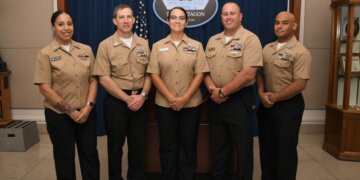Lt. Col. John “Karl” Marks never set out to hit 7,000 hours flying an A-10C aircraft. But more than 30 years into his Air Force career, he did just that.
Split among 13 deployments and thousands of combat hours, he said he just tried to “stay relevant in the airplane” and in positions that allowed him to keep flying and deploying.
“I have to just chock it up to just plain timing and luck,” said Marks, who currently is assigned to the 442nd Fighter Wing out of Whiteman Air Force Base in Johnson County, Missouri.
One of his most memorable missions occurred during the Persian Gulf War, when, alongside another pilot, he took out the most tanks of any two-ship in the war in a series of missions over the course of one day.
And then in 2018, he was part of a night mission in Afghanistan – with new wingmen in the squadron – and they took out “an entire Taliban strikeforce,” according to Marks.
RELATED: Team Rubicon helps veteran pilot find his ‘missing’ purpose
But amid those accomplishments, he was “so excited” to get in the air he said that tallying the time in flight never really crossed his mind.
“It wasn’t a specific goal or anything, and I always told people I never really chased hours,” Marks said. “I didn’t purposely try to fly longer missions.”
However, a friend who recently retired brought to Marks’ attention that he might have the most flight hours.
“I always assumed someone, somewhere had more hours than me,” Marks said.

But after hitting the 6,000 mark, he started taking note. And then flew with the squadron’s youngest pilot, 1st Lt. Dylan Mackey, to celebrate his 7,000-hour milestone.
“It’s neat that he’s going to be in the Air Force long after I’m retired,” Marks said, “and [it’ll] still be neat for him to tell people he flew with the guy who had the most hours, assuming that he doesn’t pass those.”
Mackey said via email that he learned about a week prior that he would be accompanying Marks, who had flown with Mackey’s father in the past.
“It was an honor to fly with Karl that day, and it continues to be every time we fly together,” Mackey said. “As the youngest wingman in the squadron, flying with a guy that has accumulated 7,000 hours in the A-10 is a pure blessing. He knows every trick in the book which allows me to learn something new every day. We are all very fortunate to have that kind of experience in our squadron.”
Marks’ curiosity about the Air Force started with his grandfather, who was always interested in aviation. They would visit St. Louis Lambert International Airport just to watch the airplanes take off and land.
Several of Marks’ male relatives also served in the military, though he was the first to join the Air Force.
“I think that from an early age, I was interested in fighter type aircraft, and I knew the Air Force was the place to do that,” he said.
And over the course of his thousands of hours in the sky, Marks said one of the biggest technological changes has been the creation of the helmet-mounted sighting system, which has saved pilots time in scoping out the land below.
Pilots previously had to look on the ground outside of their aircraft and correlate the location they needed to target – or avoid – which he said could take valuable time.
“Certainly there are a lot of situations we’re involved in where time is your enemy,” Marks said.
But with eyes to the sky at Whiteman AFB, Marks said he wants to continue flying A-10s until he reaches mandatory retirement.
Read comments














































